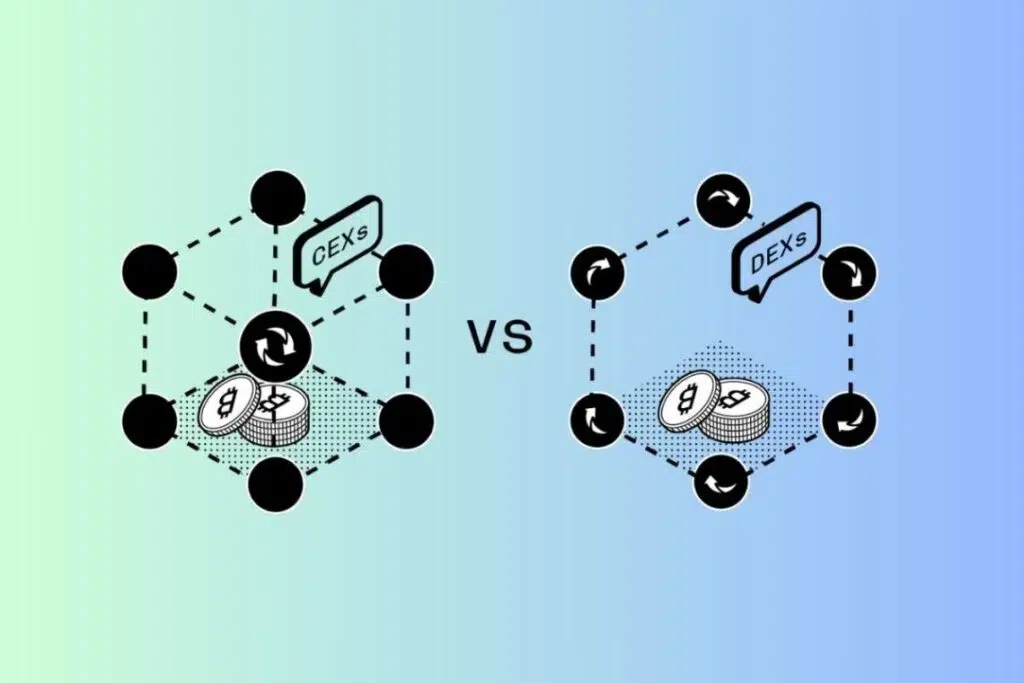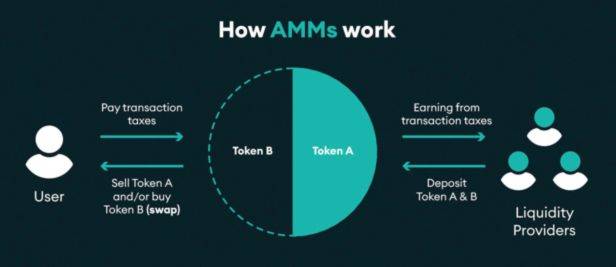Navigating crypto trades without middlemen is the dream of almost every Defi trader. This means users are opting for exchanges where the transaction fees are low, and where they have access to their private keys. It doesn’t end there, these users are also demanding platforms to be cross-compatible so that as an active user, you don’t have to move from platform to platform looking for scattered functionalities.
- What is a DEX?
- Navigating Crypto Trades Without Middlemen Using a DEX
- The Role of Automated Market Makers (AMMs) on Standard DEXs
- Order Book DEXs
- DEX Aggregators
- How to Trade on a DEX?
- Advantages of a DEX
- Mitigated Counterparty Risk
- Mitigated Security Concerns
- Preserving Anonymity
- Token Accessibility
- Interoperability
- The Future of DEX Trading
- Conclusion
Navigating crypto trades without middlemen isn’t straightforward as it may seem but is possible by relying on decentralized exchanges (DEXs). These platforms ensure you can execute transactions directly on the platform though a smart contract without depending on an intermediary to facilitate the trade, or a custodial to manage the funds.
The primary goal behind DEXs is to liberate users from the shackles of centralized authorities overseeing and authorizing trades. Facilitating peer-to-peer (P2P) trading of cryptocurrencies, these exchanges connect buyers and sellers without the custodial baggage. Typically non-custodial DEXs empower users to retain control over their wallet private keys.
Private keys, the cryptographic keys enabling access to cryptocurrencies, allow users to instantly check their crypto balances upon logging into the DEX. Importantly, users aren’t compelled to disclose personal information such as names and addresses, catering to privacy-conscious individuals.
Innovative solutions like automated market makers addressing liquidity challenges have helped propel the decentralized finance (DeFi) space’s growth.
Furthermore, the emergence of DEX aggregators and wallet extensions has optimized token prices, swap fees, and slippage, providing users with superior rates. With these advancements, decentralized platforms are flourishing, offering a secure and private environment for crypto enthusiasts.
Navigating crypto trades without middlemen highlights the benefits of eliminating 3rd party involvement when trading cryptocurrency. You will also discover how a DEX called ChaiDEX is facilitating cross-chain trading without the need for token bridges.
What is a DEX?
Decentralized exchanges (DEXs) leverage smart contracts, empowering traders in navigating crypto trades without middlemen by execute orders through smart contracts.

Centralized exchanges dominate the cryptocurrency market’s trading volume due to their regulation, custody of users’ funds, and user-friendly interfaces catering to newcomers. Some even offer insurance on deposited assets, mimicking traditional banking services.
The services provided by centralized exchanges mirror those of banks, ensuring the safety of clients’ funds and offering security and surveillance services that individuals cannot independently provide. This centralized model facilitates the smooth movement of funds.
Conversely, decentralized exchanges enable users to trade directly from their wallets by engaging with the smart contracts underpinning the trading platform. Traders bear the responsibility of safeguarding their funds, and any mistakes, such as losing private keys or sending funds to incorrect addresses, may lead to losses.
Deposited funds or assets on decentralized exchanges are represented by an “I owe you” (IOU), tradable across the network. Essentially, an IOU is a blockchain-based token with the same value as the underlying asset.
Leading decentralized exchanges are constructed on prominent blockchains supporting smart contracts, functioning as layer-one protocols directly integrated into the blockchain. Notably, the Ethereum blockchain hosts the most popular DEXs, marking a pivotal shift in the landscape of crypto trading.
Navigating Crypto Trades Without Middlemen Using a DEX
Operations of a DEX are rooted in blockchain networks supporting smart contracts, where users maintain control over their funds. With this foundation, each trade on a DEX incurs both a transaction fee and a trading fee, as traders engage directly with smart contracts on the blockchain.
DEXs come in three primary forms: Automated Market Makers (AMMs), Order Book DEXs, and DEX Aggregators. Regardless of their categorization, these platforms facilitate direct user-to-user trading through their respective smart contracts. In the initial stages, the earliest decentralized exchanges adopted order books akin to those used by centralized exchanges.
The problem with cross-chain transactions on a decentralized exchange is the reliance on bridging solutions to facilitate communication between L1 and L2 chains. This not only increases inefficiency but also increases the cost of crypto trading on a DEX. As such, innovators are opting for a blockchain-agnostic model like that of ChaiDEX to eliminate middlemen, reduce the cost of trading and facilitate multichain transactions.
ChaiDEX is a decentralized and peer-to-peer (P2P) crypto exchange that implements non-custodial, multichain support and automated market-making to facilitate transparent and fully decentralized crypto trades.
The exchange utilizes a hybrid exchange model to benefit from the efficiencies of centralized and decentralized exchanges but yet eliminate their disadvantages. Some of the disadvantages of decentralized exchanges that ChaiDEX is solving with its hybrid model include a lack of compatibility across different chains, high trading costs, and reliance on bridging solutions.
However, a DEX exchange comes with several advantages including high security, full transparency, community governance, control,full ownership and sticking to Web3 principles.
It is these advantages that ChaiDEX aims to satisfy with its DEX aspects. On the other hand, centralized exchanges are notorious for their lack of onchain data, insufficient security, users lack of private keys and control of their funds. However, centralized exchanges offer unmatched ease of trading. It is this unmatched user experience that ChaiDEX has beaten through its P2P decentralized exchange.
Visit ChaiDEX to trade with extra-low transaction fees on their platform.
To make sure there are no middlemen when transacting on ChaiDEX, the exchange implements an escrow contract. This contract identifies each trade using a unique identification address The escrow holds assets from both ends of a trade and ascertains that both parties meet particular terms before approving a transaction.
If one or both of the parties do not meet these predefined conditions, a smart contract terminates the trade.Thereby returning the user funds back to their respective owners. This ensures that the DEX releases the transfer of assets to the other end without relying on a middle-party. Usually, both parties to a transaction must meet the conditions within an allotted time span.
The Role of Automated Market Makers (AMMs) on Standard DEXs
In addressing the liquidity challenge within decentralized exchanges, the automated market maker (AMM) system emerged, leveraging smart contracts. Inspired in part by Ethereum co-founder Vitalik Buterin’s pioneering paper on decentralized exchanges, AMMs execute trades on the blockchain through contracts holding tokens.

These AMMs operate with blockchain oracles, which fetch information from various sources to determine the prices of traded assets. Unlike traditional exchanges that match buy and sell orders, AMMs utilize smart contracts and pre-funded pools of assets known as liquidity pools.
Users fund these pools, becoming liquidity providers entitled to transaction fees the protocol charges for executing trades on specific pairs. Liquidity providers deposit an equivalent value of each asset in the trading pair, engaging in liquidity mining to earn interest on their cryptocurrency holdings. Attempting to deposit an uneven amount triggers the smart contract to invalidate the transaction.
The use of liquidity pools enables traders to execute orders or earn interest in a permissionless and trustless manner. These exchanges are often evaluated by their total value locked (TVL), which represents the funds secured in their smart contracts. However, the AMM model faces challenges, particularly in terms of slippage, when liquidity is insufficient.
Slippage occurs when a lack of liquidity leads to buyers paying above-market prices, with larger orders experiencing higher slippage. This drawback may dissuade wealthier traders, as substantial orders are prone to slippage without robust liquidity.
Liquidity providers encounter risks such as impermanent loss, stemming from depositing two assets for a specific trading pair. If one asset is more volatile, fluctuations can reduce the amount of that asset in the liquidity pool. Impermanent loss is mitigated over time through fees collected from trading, compensating providers as the pair’s ratio adjusts.
Primarily, users find themselves restricted to basic swap trades, with immediate or market orders as the predominant options. Furthermore, the tokens available on a DEX are confined to specific chains such as Ethereum (ERC-20) or Binance Smart Chain (BEP-20), necessitating users to navigate the intricate process of bridging their tokens and constantly switching networks within different browser extensions, if the DEX supports multiple chains.
Adding to the complexity, gas fees on DEXs can surpass traditional exchange fees, presenting an economic consideration that demands attention.This is due to reliance on middleparty services e.g bridging solutions.
Notably absent are robust charting engines akin to TradingView, leaving users without the tools to swiftly evaluate a token’s performance or employ technical indicators. Moreover, mobile support faces limitations due to incompatibility issues which makes it impossible to trade on the go when using a DEX.
These challenges have cast a shadow over the continued growth of DEXs, with their dominance waning in recent months, accounting for only 55% of the overall trade volume.
While seasoned experts may navigate these intricacies with a semblance of ease, the process remains alarmingly convoluted. For novices, the advice is unequivocal: bask in the comforting neon glow of a CEX, but tread cautiously by trading only hand-selected assets and relinquishing true asset ownership.
Even for seasoned experts, the deficiency in essential functions, such as limit buys, stop-losses, market and conditional orders, and profit-taking orders, imposes severe limitations on strategic execution.
Attempting to implement advanced strategies, such as a trailing stop-loss, on a DEX requires an unwavering commitment to the screen, with an overwhelming number of open browsers, and success remains uncertain even under the best efforts, as capturing the precise price becomes a problem.
The emergence of Hybrid DEX platforms, the likes of ChaiDEX signifies a shift towards incorporating the traditional CEX experience onto the blockchain.
Recognizing the significance of providing traders with the best features of centralized exchanges, Hybrid DEXs prioritize enabling users to maintain custody of their cryptocurrencies throughout the trading process.
To streamline the user experience, these platforms are not only cross-chain but also interoperable, allowing traders the convenience of executing all their transactions within a singular interface. This inclusivity extends beyond desktop environments to include both browser and mobile accessibility, catering to the diverse preferences of users.
Furthermore, recognizing the diverse users in crypto, Hybrid DEXs are committed to delivering an intuitive and aesthetically pleasing user interface, ensuring that beginners are not overwhelmed. Thereby ensuring they can engage in trading activities with confidence rather than shouldering the inefficiencies of middlemen.
In essence, the advent of Hybrid DEX platforms seeks to transcend the limitations of traditional decentralized exchanges, providing a comprehensive and user-friendly trading environment that encapsulates the best of both decentralized and centralized worlds.
Order Book DEXs
Order book DEXs play a pivotal role by compiling comprehensive records of open orders for specific asset pairs. Within these records, buy orders signify a trader’s willingness to bid for an asset at a specific price, while sell orders indicate a trader’s readiness to ask a particular price for the asset. The spread between these prices determines the depth of the order book and, consequently, the market price on the exchange.
Order book DEXs come in two varieties: on-chain order books and off-chain order books. DEXs utilizing on-chain order books store open order information on the blockchain, ensuring users’ funds remain secure in their wallets. Some of these exchanges permit traders to amplify their positions by borrowing funds from lenders on the platform. While leveraged trading enhances earning potential, it concurrently escalates the risk of liquidation, as borrowed funds must be repaid even in the event of a losing bet.
On the other hand, DEX platforms adopting off-chain order books only settle trades on the blockchain, aiming to bring the advantages of centralized exchanges to traders. This approach minimizes costs and accelerates transaction speeds, ensuring trades are executed at desired prices. These exchanges also facilitate leveraged trading by allowing users to lend their funds to fellow traders. Loaned funds accrue interest over time, secured by the exchange’s liquidation mechanism, guaranteeing lenders payment even in the face of traders’ losses.
It’s worth noting that order book DEXs often grapple with liquidity challenges. Competing with centralized exchanges and incurring extra fees for on-chain transactions, these platforms sometimes face user preference for centralized alternatives. While DEXs with off-chain order books mitigate some costs, they introduce smart contract-related risks due to the necessity of depositing funds.
DEX Aggregators
DEX aggregators strategically employ various protocols and mechanisms to tackle liquidity-related challenges. These platforms serve as a nexus, consolidating liquidity from multiple decentralized exchanges (DEXs) to mitigate slippage on substantial orders, fine-tune swap fees and token prices, and deliver traders the optimal price in the shortest time frame.
Two pivotal objectives of DEX aggregators are shielding users from the pricing impact and diminishing the likelihood of transaction failures. To enhance user experience, some aggregators even tap into liquidity from centralized platforms, seamlessly integrating with specific centralized exchanges while maintaining a non-custodial approach.
How to Trade on a DEX?
Engaging with decentralized exchanges (DEXs) is remarkably straightforward, bypassing the need for a sign-up process or even an email address. Instead, users require a wallet compatible with the smart contracts on the chosen exchange’s network, making these financial services accessible to anyone with a smartphone and an internet connection.
To embark on the DEX journey, users first need to determine the network they wish to use, considering that each trade involves a transaction fee. Subsequently, selecting a wallet compatible with the chosen network and funding it with its native token becomes the next crucial step. The native token serves as the currency for covering transaction fees within a specific network.
Wallet extensions, seamlessly integrated into browsers, facilitate easy interaction with decentralized applications (DApps) like DEXs. These extensions, easily installable, offer users the option to import an existing wallet through a seed phrase or private key or create a new one, with an added layer of security through password protection.
Mobile applications associated with these wallets enable traders to harness the power of DeFi protocols on the go, featuring built-in browsers for interacting with smart contract networks. Synchronization between devices is possible by importing the wallet from one device to another.
Once a wallet is chosen, it needs to be funded with tokens earmarked for covering transaction fees on the selected network. These tokens can be acquired from centralized exchanges, easily recognizable by ticker symbols such as ETH for Ethereum. After purchasing, users simply withdraw the tokens to their controlled wallets.
It is paramount to exercise caution and ensure funds are directed to the correct network to avoid any mishaps. With a funded wallet, users can seamlessly connect to DEXs by responding to a pop-up prompt or clicking the “Connect Wallet” button positioned in the upper corners of the DEX website.
Advantages of a DEX
Mitigated Counterparty Risk
Decentralized exchanges effectively nullify counterparty risk, a concern stemming from the possibility of the other party in a transaction failing to fulfill its contractual obligations. Decentralized exchanges eliminate this risk entirely by operating without intermediaries and relying on smart contracts.
To further assure users of a DEX’s reliability, individuals can conduct a quick web search to ascertain whether the exchange’s smart contracts have undergone audits. This additional step empowers users to make informed decisions based on the experiences of other traders, ensuring a comprehensive risk assessment before engaging in transactions.
Mitigated Security Concerns
Seasoned cryptocurrency users who exercise custody over their funds experience reduced vulnerability to hacking when utilizing DEXs. The decentralized nature of these exchanges ensures that users, not the platform, maintain control over their funds.
Traders safeguard their assets and only engage with the exchange when actively trading. In the unfortunate event of a platform hack, the primary risk typically lies with liquidity providers, while individual traders are less susceptible to direct security threats.”
Preserving Anonymity
Decentralized exchanges (DEXs) prioritize user anonymity when swapping one cryptocurrency for another. Unlike centralized exchanges, DEX users are exempt from the customary identification procedures known as Know Your Customer (KYC). KYC processes typically entail the collection of traders’ personal information, including their full legal name and a photograph of their government-issued identification document. This distinction makes DEXs particularly appealing to a significant demographic seeking to engage in cryptocurrency transactions without the need for identification.
Token Accessibility
In the realm of centralized exchanges, each token undergoes individual scrutiny and must adhere to local regulations before being listed. In contrast, decentralized exchanges have the flexibility to include any token minted on the blockchain they operate on. Consequently, new projects are likely to debut on decentralized exchanges before making their way to their centralized counterparts.
While this early access offers traders the opportunity to engage with projects at an early stage, it also introduces a vulnerability to various scams on decentralized exchanges. One prevalent scam is the ‘rug pull,’ a deceptive exit strategy. Rug pulls occur when the project team behind a token exploits the rising price by offloading the tokens used for liquidity in the exchange’s pools. This maneuver renders it challenging for other traders to sell their holdings, resulting in potential losses for unsuspecting investors.
Do you want to trade on ChaiDEX? Visit their official website to learn more.
Interoperability
ChaiDEX stands at the forefront of addressing the intricate challenge of interoperability within the blockchain landscape, recognizing that blockchain, in its essence, functions as a shared ledger delineating immutable transactions.
Despite the fundamental similarity of various blockchain networks, the reality is one of standalone, single and independent operation.Thereby limiting access to DApps that function outside the DEX blockchain. This is why ChaiDEX is at the forefront to build the first blockchain agnostic DEX exchange.
Consider the predicament of Ethereum users who aren’t able to navigate dApps within the Ethereum ecosystem but encounter formidable barriers when attempting to extend their interactions to dApps on other networks such as Avalanche or Solana.
This fragmented ecosystem compels users to disperse their assets across different networks, giving rise to inefficiencies that undermine the smooth functioning of decentralized finance (DeFi) protocols and, in turn, impede widespread adoption of other blockchain DApps.
In response to this challenge, ChaiDEX emerges as a holistic solution that fosters interoperability between different blockchain networks. By bridging the gaps that traditionally hinder cross-chain communication, ChaiDEX ensures that users can engage with a spectrum of dApps under one unified roof.
This transformative approach not only enhances user convenience but also contributes to the fluidity and efficiency of the decentralized ecosystem, marking a significant stride towards the realization of a highly interoperable and user-centric blockchain landscape.
Cross-chain interoperability serves as a crucial linchpin, facilitating the seamless exchange of assets across otherwise isolated networks.
This interoperability is particularly vital in the decentralized finance (DeFi) ecosystem, which boasts a valuation exceeding $40 billion, with Ethereum constituting over 58% of its total worth.
The absence of cross-chain interoperability would essentially render users on non-Ethereum networks unable to access this flourishing ecosystem.
Traditionally, cross-chain interoperability has been possible via the token bridges, specialized solutions that facilitate exchange of assets between two distinct blockchain networks. These bridges operate by locking an asset on one blockchain and generating a wrapped version of that asset on the receiving blockchain.
For instance, in a swap between ETH and SOL, the user receives a wrapped SOL (wSOL) in their wallet, while the corresponding ETH is locked on the Ethereum network. The wrapped SOL retains the same monetary value as the locked ETH. Upon bridging back, the wrapped SOL is burned, and the locked ETH is released, restoring liquidity.
However, an innovative and more promising approach to achieving cross-chain interoperability has emerged through the utilization of decentralized exchanges (DEXs). ChaiDEX, in particular, distinguishes itself by relying on atomic swaps, a trustless peer-to-peer exchange method conducted through smart contracts between two individual wallets. This mechanism employs a hashed timelock contract (HTLC), establishing a predefined timeframe for the completion of the transaction.
Both parties engaged in the transaction must furnish cryptographic evidence of their ownership of the assets involved in the exchange. Should either party fail to provide this proof within the stipulated time frame, the transaction is automatically canceled, and the respective cryptocurrencies are returned to their original wallets.
By harnessing the power of atomic swaps, ChaiDEX eliminates the need for traditional cross-chain token bridges, offering users a more efficient, secure, and decentralized means of conducting crypto trades across diverse blockchain networks.
The Future of DEX Trading
Decentralized exchanges made their debut in 2014, but their prominence rose when decentralized financial (DEFI) services, underpinned by blockchain, gained widespread acceptance. The advent of Automated Market Maker (AMM) technology further addressed the liquidity challenges that initially hindered the growth of DEXs.
There are challenges that these platforms face when enforcing Know Your Customer (KYC) and Anti-Money Laundering (AML) checks. Particularly considering the absence of a central entity for verifying KYC information on the blockchain. Despite this, regulatory efforts may aim to implement such checks on decentralized exchanges in future. Thereby undermining the complete picture of Web3. However, DEXs like ChaiDEX that don’t need the help of 3rd party services might not face this problem.
Distinct from custodial entities, decentralized exchanges operate outside the purview of regulations applicable to custodians. Even those accepting user deposits require users to sign messages on the blockchain to facilitate fund transfers off their platforms.
Modern decentralized exchanges like ChaiDEX offer users diverse opportunities, including borrowing funds for leveraged positions, lending funds for passive interest income, and unparalleled liquidity to earn trading fees.
Being built on self-executing smart contracts, these platforms hold the promise of generating more use cases in the future. A noteworthy example is the emergence of flash loans, where loans are initiated and repaid within a single transaction. This exemplifies how innovation in the decentralized finance space can give rise to novel products and services previously deemed unattainable.
ChaiDEX is building the feature of decentralized P2P exchange through its noncustodial, cross-chain, and multiasset hybrid DEX features to transform cryptocurrency trading.
As a decentralized peer-to-peer exchange, ChaiDEX enhances direct trade by eliminating middlemen and streamlining affordable cross-chain transactions. Trading on ChaiDEX is alot cheaper, and faster and extends compatibility across different blockchains.
Thanks to its decentralized blockchain-agnostic features, cryptocurrency traders can rely on ChaiDEX for all types of digital asset transactions.
Jaydip Rathod, an expert across Real Estate, IT, Construction, Fintech and the blockchain is leading the revolution at ChaiDEX, alongside Nitesh Mishra, Chief Technology Officer, and Pramoda Kalkoti, Chief Product Officer. Nitesh and Pramoda bring a wealth of experience across technology, blockchain, and business.
Participants who would love to join the ChaiDEX revolution can also do so by becoming ambassadors through a generous referral program that is officially sponsored by ChaiDEX. Furthermore, the exchange has its own tokenomics that are driven by the exchange’s main utility token, $CHAIT. The token ($CHAIT) is capped at a maximum supply of 1.0 billion tokens.
To enhance user experience and security, ChaiDEX also offers a non custodial wallet called Chai Wallet. The wallet aims to fortify the safety and security of funds for traders who prefer self-custodial rather than custodial crypto storage solutions. Since ChaiDEX is blockchain agnostic, Chai Wallet follows the same route through its cross chain support and interoperable features that do not need bridging solutions to facilitate multichain trades.
Conclusion
Complete Web3 ethos are essential for the entire trading lifecycle. These ethos include decentralization, transparency, security, community governance, and user control. Cryptocurrencies have upheld this ethos so well with their unparalleled decentralization, transparency, and ownership aspects.
However, some of the platforms that facilitate crypto ownership, storage, and exchanging have failed to satisfy the requirements of a standalone web3 ecosystem. Such platforms are custodial wallets that deprive users of their control of private keys, exchanges that offer centralized trades and those that wrap tokens, or those that rely on centralized 3rd party services. This situation has led to high demand for platforms that observe the complete web3 ethos so that users can get back control, ownership, and management of assets.
In the above blog post,“Navigating Crypto Trades without Middlemen” we’ve observed how crypto exchanges can eliminate reliance on 3rd party solutions when facilitating P2P and decentralized trades. One of the first exchanges to implement a fully decentralized yet hybrid model for its DEX is ChaiDEX. The revolutionary DEX provides unparalleled interoperability, cheap transaction fees, and faster speeds. We discovered how ChaiDEX benefits decentralized trades through its noncustodial features, and its official wallet, Chai Wallet.



















